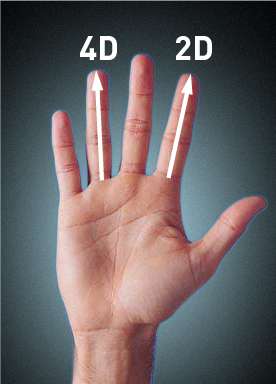Verbal aggression: You may have picked it up in the womb, says new study

(Medical Xpress)—Research on the communication trait of verbal aggressiveness, which includes behavior like name calling, ridicule, insults, racial epithets and threats, has tended to focus on its social causes.
However, a new study by a team of researchers led by Allison Z. Shaw, PhD, assistant professor of communication at the University at Buffalo, has found that verbal aggression may have biological causes that can be identified by the ratio of length of a person's ring finger (second digit) to the length of the index finger (fourth digit).
It is the first study to use the 2D:4D ratio – considered a measure of prenatal testosterone exposure – as a determinant of verbal aggression.
The study, "The Effect of Prenatal Sex Hormones on the Development of Verbal Aggression," was published in the Journal of Communication (Vol. 62 No. 5) and its authors include Michael R. Kotowski, assistant professor of communication, University of Tennessee, and Franklin J. Boster and Timothy R. Levine, both professors of communication at Michigan State University.
Shaw says prior research has suggested that the 2D:4D ratio can be used as a measure of exposure to androgens in utero (testosterone being a type of androgen) and a number of studies have shown a correlation between the 2D:4D ratio and various physical and behavioral traits.
The research team hypothesized that if prenatal exposure to testosterone influences the 2D:4D ratio and high levels of prenatal testosterone exposure are linked to verbal aggression, then digital ratio could predict the trait of verbal aggression.
To test this, they first measured the finger length of adult subjects from the point where fingers meet the palm to the tip, then photocopied each hand, palm down and made the same measurements. From these results they calculated each subject's 2D:4D ratio.
The subjects then filled out the Verbal Aggression Scale and the HEXACO Personality Inventory and the Argumentativeness Scale.
The team found that men and women with smaller 2D:4D ratio reported themselves to be more verbally aggressive.
Shaw points out that, when expressed in limited contexts, verbal aggression can be beneficial to an individual but when expressed injudiciously, may have negative influences by provoking job loss, for example, or making it difficult to maintain close personal relationships.
"These findings have implications for our understanding of the proximal and distal causes of verbal aggression," Shaw says.
"They suggest," she says, "that verbally aggressive behavior may be provoked by biologically based differences in people's attention to potentially threatening stimuli (such as a sigh), their appraisal of the stimuli as threatening and the resulting decision to respond and produce messages that are verbally aggressive.
"This study is the first step in gaining a better understanding of this process," says Shaw, "and may allow us to develop more sophisticated techniques to inhibit such types of responses."













